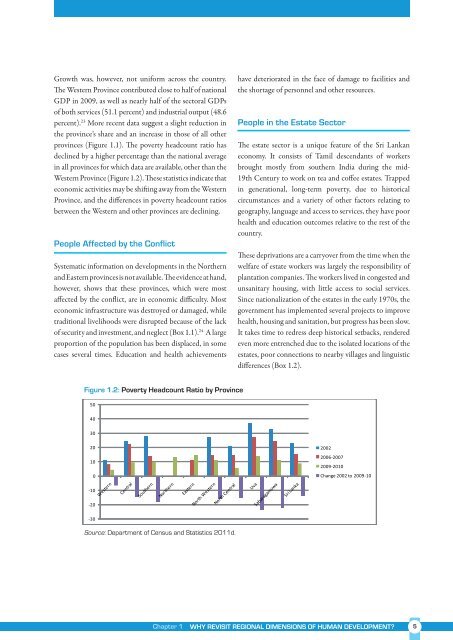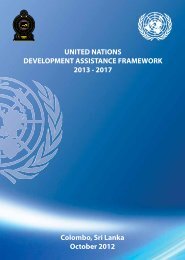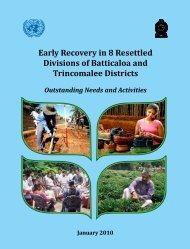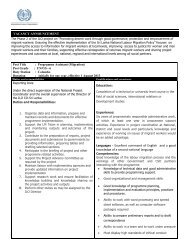Sri Lanka Human Development Report 2012.pdf
Sri Lanka Human Development Report 2012.pdf
Sri Lanka Human Development Report 2012.pdf
Create successful ePaper yourself
Turn your PDF publications into a flip-book with our unique Google optimized e-Paper software.
Growth was, however, not uniform across the country.<br />
The Western Province contributed close to half of national<br />
GDP in 2009, as well as nearly half of the sectoral GDPs<br />
of both services (51.1 percent) and industrial output (48.6<br />
percent). 23 More recent data suggest a slight reduction in<br />
the province’s share and an increase in those of all other<br />
provinces (Figure 1.1). The poverty headcount ratio has<br />
declined by a higher percentage than the national average<br />
in all provinces for which data are available, other than the<br />
Western Province (Figure 1.2). These statistics indicate that<br />
economic activities may be shifting away from the Western<br />
Province, and the differences in poverty headcount ratios<br />
between the Western and other provinces are declining.<br />
People Affected by the Conflict<br />
Systematic information on developments in the Northern<br />
and Eastern provinces is not available. The evidence at hand,<br />
however, shows that these provinces, which were most<br />
affected by the conflict, are in economic difficulty. Most<br />
economic infrastructure was destroyed or damaged, while<br />
traditional livelihoods were disrupted because of the lack<br />
of security and investment, and neglect (Box 1.1). 24 A large<br />
proportion of the population has been displaced, in some<br />
cases several times. Education and health achievements<br />
have deteriorated in the face of damage to facilities and<br />
the shortage of personnel and other resources.<br />
People in the Estate Sector<br />
The estate sector is a unique feature of the <strong>Sri</strong> <strong>Lanka</strong>n<br />
economy. It consists of Tamil descendants of workers<br />
brought mostly from southern India during the mid-<br />
19th Century to work on tea and coffee estates. Trapped<br />
in generational, long-term poverty, due to historical<br />
circumstances and a variety of other factors relating to<br />
geography, language and access to services, they have poor<br />
health and education outcomes relative to the rest of the<br />
country.<br />
These deprivations are a carryover from the time when the<br />
welfare of estate workers was largely the responsibility of<br />
plantation companies. The workers lived in congested and<br />
unsanitary housing, with little access to social services.<br />
Since nationalization of the estates in the early 1970s, the<br />
government has implemented several projects to improve<br />
health, housing and sanitation, but progress has been slow.<br />
It takes time to redress deep historical setbacks, rendered<br />
even more entrenched due to the isolated locations of the<br />
estates, poor connections to nearby villages and linguistic<br />
differences (Box 1.2).<br />
Figure 1.2: Poverty Headcount Ratio by Province<br />
Source: Department of Census and Statistics 2011d.<br />
Chapter 1 WHY REVISIT REGIONAL DIMENSIONS OF HUMAN DEVELOPMENT 5






